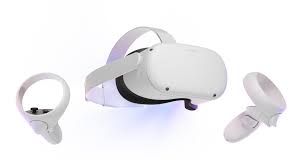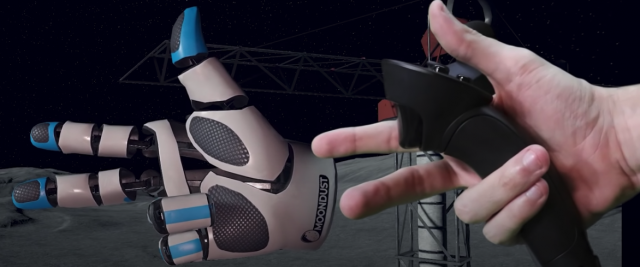VR Devices
I have compiled a table featuring 4 popular VR devices, as well as their respective specifications, for ease of comparison. These key specifications, including Degree of Freedom (DOF) and Field Of View (FOV), were chosen as basis of comparison due to their high relevance and importance in providing immersion in the VR experience.
| Specs | Playstation VR | Valve Index | Nintendo Labo VR | Oculus Quest 2 |
| Category | Tethered | Tethered | Standalone | Standalone |
| Degree of Freedom | 6DOF | 6DOF | 3DOF | 6DOF |
| Field of View | 100° | 130° | 110° | 90° |
| Resolution (pixels) | 1920 x 1080 | 2880 x 1600 | 1280 x 720 | 3664 x 1920 |
| Refresh Rate | 120hz | 144hz | 60hz | 90hz |
| Cost (USD) | 299 | 999 | 79.90 | 299 |
Favourite VR Device: Oculus Quest 2

I ultimately favoured the Oculus Quest 2 over the other choices due to several reasons:
Firstly, it is a standalone VR headset and has a built-in display and audio processor, and using it is relatively hassle-free. This is opposed to the tethered playstation VR and Valve Index, which requires it to be connected to a PC to work.
Of course, I understand that tethered headsets are able to leverage on the powerful PCs to provide higher quality immersion. For example, the Valve Index is considered a higher-end headset of choice, and is able to take advantage of the PC’s computing power to push high refresh rates up to 144hz. It is also able to perform individual finger tracking with its controllers as well:

Despite the fact that tethered VR headset can supposedly provide more immersion, I identify as a casual VR user and do not see the need to invest in a high-end VR set at the moment. I believe that the Oculus Quest 2 is good enough for my needs in exploring the field of VR, and appreciate the fact that I can use the headset without much prior set up.
Secondly, I value the 6DOF that the Oculus Quest 2 provides. I’m not just young and dumb, I’m also broke. Hence, as I invest my money into Oculus Quest 2, I also expect a good level of immersion, which I believe can lead to a good level of presence. While VR headsets like the Nintendo Labo VR only provides 3DOF (tracking the rotation of your head), the Oculus Quest 2 also tracks your movement with inside-out tracking, a method that uses sensors on the device to scan the surroundings and determine your position. This is opposed to the Valve Index, which requires setting up external base station stands to track your surroundings.
Thirdly, the Oculus Quest 2 provides almost 4K resolution, beating the others in this area. Having a higher resolution can truly enhance the immersion, and make me temporarily forget about my sad, sad life. Hence, increasing the presence of the VR experience.
Lastly, I believe that at $299, the Oculus Quest 2 is worth it. While the cheapest on the list is the Nintendo Labo VR, it’s specs are (unsurprisingly) poorer than the rest, and undoubtedly would provide the least amount of immersion. It is more aimed at super-casual gamers or kids that want to have a taste of VR. The Oculus Quest 2 on the other hand, is reasonably priced given the amount of power it packs. Although the playstation VR is priced similarly to the Oculus Quest 2, I will still go with the Oculus Quest 2 because it is a standalone headset.
MR Devices
Below are 2 MR Devices that I think are great:
| Specs | Microsoft Hololens 2 | Magic Leap One |
| Category | Standalone | Standalone |
| Degree of Freedom | 6DOF | 6DOF |
| Field of View | 52° | 50° |
| Resolution (pixels per eye) | 2048 x 1080 | 1280 x 960 |
| Refresh Rate | 120Hz | 120Hz |
| Cost (USD) | $3500 | $2295 |
Favourite MR device: Microsoft Hololens 2

I believe that both devices listed have their merits. However, I decided to go with Microsoft Hololens for these reasons:
Firstly, as a casual user of MR technologies, one of my main focuses is the ability to run interesting and fun programmes on the device. The Microsoft Hololens 2 is developed by Microsoft and the Magic Leap One is relatively new, developed by Magic Leap. The Microsoft Hololens 2 is able to run programmes that were developed for the original Hololens, while there is stark lack of content for the Magic Leap One. This is important to me because I like to keep things fresh and new and having few programs to choose from will cause the novelty to wear off.
Next, while the Magic Leap One has hand-tracking, it also provides a controller for the user to use, which is great in itself. But I’ve also read that the Microsoft Hololens 2 doesn’t even need controllers, and relies solely on hand-tracking via cameras on the device, and has significantly better hand tracking, even being able to “identify [the user’s] ten fingers with ease”. This provides the user with more immersion as it can better simulate real life, most likely leading to higher presence.
Also, just by looking at the specifications, we can see that the Hololens 2 beats the Magic Leap One on two important factors: Field of View and Resolution. This is what makes the Hololens 2 a better quality MR device, increasing the immersion.
While the Microsoft Hololens 2 would naturally cost more ($3500) compared to the Magic Leap One ($2295), I feel safer investing in a product developed by a well-known brand in Microsoft. Furthermore, the Hololens 2 is already their second edition of the Hololens series, which shows how Microsoft already has much more experience in building, giving them an added advantage in enhancing their MR device as compared to Magic Leap.
